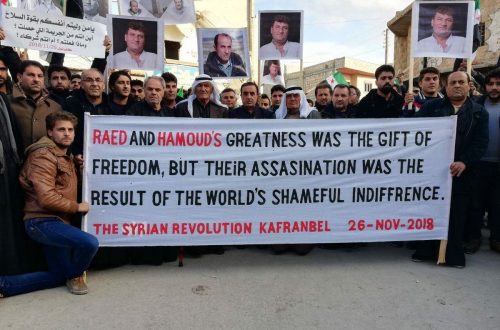We’ve posted a lot about the Syrian uprising since it began in earnest last March. But nothing I’ve read about it captures the reign of fear, terror and barbarity imposed by the Assad regime, and the astonishing bravery of the hundreds of thousands of Syrians who have taken to the streets in an effort to oust that regime, as a report from Homs by Wolfgang Bauer, a correspondent for the German newspaper Zeit.
Bauer traveled secretly in Syria and met with Syrians who risked their lives even to speak with him.
All morning in Homs, Syria’s third-largest city, dozens of people have been taken from their apartments. Nobody knows exactly how many. Armed secret police are moving from door to door. Now and again, a volley of gunshots shatters the silence in the streets. Ahmed, who is in his mid-50s, steps out of his home straight-backed to conceal his fear. “They smell it,” he says. “They’re trained for that.” As Ahmed steps out, I, the visitor from abroad, flee to the back rooms of the apartment. Ahmed and Faten’s house is my hideout. The family elders have discussed and decided that they’ve decided to risk everything for me, their freedom and their lives so that this story can be written. “You must report!” Ahmed had said. “The world must know what’s happening in our city!”
The Syrian revolution is the most unexpected of all Arab uprisings this year. Everyone, even abroad, assumed that President Bashar al-Assad was immune to unrest given his tight network of some two dozen competing security agencies. For the past half year, Assad has used excessive violence against his opponents. Tanks have been firing on civilians, war ships on cities. But the brutality has so far achieved only the opposite of what Assad wanted – the protests are expanding, they’re spreading through the entire country and are drawing ever more people. Since the beginning of the unrest, the regime has sealed off its borders to the foreign media. It simply doesn’t want any witnesses. Officially, there isn’t a single independent correspondent in the country at the moment. Assad, a former eye doctor, is all too aware about the power of images. He knows that the international media will only report what they can show. If there are no images, then probably won’t be much reporting. So the world can only see an unfocused and blurry Syria as seen on photos taken by demonstrators in Damascus and Homs on their mobile phones. The photos have a faraway quality much like the images that NASA robots transmit from Mars to Earth. It’s as if Syria has fallen off the map.
After reading Bauer’s piece, Terry Glavin makes a comparison (apt, I think) between Homs in 2011 and the Warsaw Ghetto in 1943.
Terry also wonders why supposedly anti-totalitarian Westerners are standing on the sidelines. He makes the point— also made by Jonathan Freedland, Carne Ross and (a few years ago) Paul Berman— that Western anti-totalitarians and democrats don’t have to wait for their governments to act; there is plenty they can do themselves.
(Hat tip: normblog)


